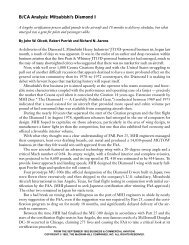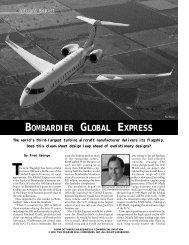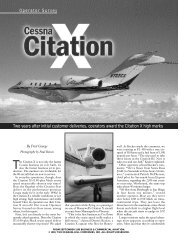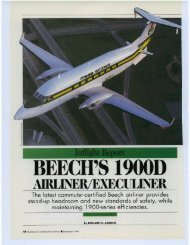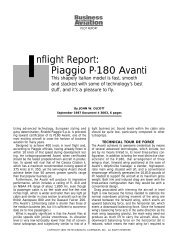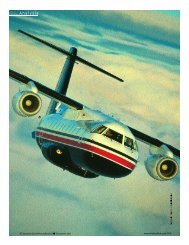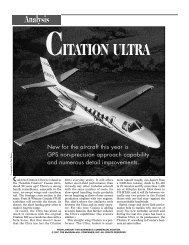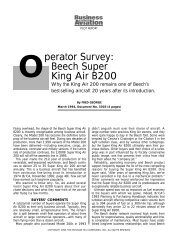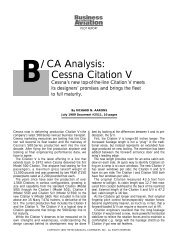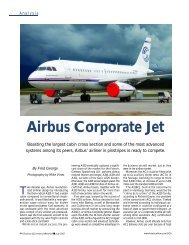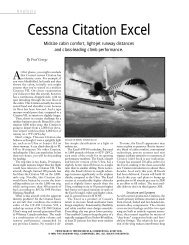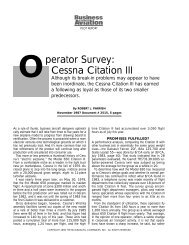You also want an ePaper? Increase the reach of your titles
YUMPU automatically turns print PDFs into web optimized ePapers that Google loves.
PILOT REPORT<br />
O<br />
perator Survey:<br />
<strong>731</strong> <strong>Falcon</strong> <strong>20</strong><br />
Built to endure, many of Dassault’s popular<br />
<strong>Falcon</strong> <strong>20</strong> business jets are enjoying a new<br />
longer-legged, more economical lease on life.<br />
By ROBERT L. PARRISH<br />
August 1992, Document No. 2604 (4 pages)<br />
In the corporate segment of aviation, where inflated<br />
development and certification costs coupled with a congressionally<br />
mandated luxury tax appear to have<br />
clamped a damper on new aircraft sales, there is a<br />
glimmering hope for continuing expansion. It lies in the<br />
visibly growing business of marrying the latest technology<br />
propulsion systems and avionics with seasoned but<br />
still airworthy airframes.<br />
One of the more promising of these programs is the<br />
retrofit of the Dassault <strong>Falcon</strong> <strong>20</strong> with EFIS and Garrett<br />
TFE<strong>731</strong>-5 series turbofan powerplants. Depending<br />
on options, the cost ranges from $4.3 million to $7.5<br />
million.<br />
Designed in the late 1950s and placed in production<br />
in 1965, the <strong>Falcon</strong> <strong>20</strong> was the first (and allegedly is<br />
still the only) business jet to be put through the fatigue<br />
test equivalence of 90 years of flying, thereby earning<br />
FAA certification with no life limits on the airframe.<br />
Originally powered with General Electric CF700<br />
fanjet engines rated at 4,125 pounds takeoff thrust,<br />
the 26,455-pound gross weight standard <strong>Falcon</strong> <strong>20</strong><br />
provided spacious cabin comfort that passengers<br />
found appealing but with speed, altitude and range<br />
limitations that were often anxiety-inducing to<br />
flightcrews. Over a production span of nearly <strong>20</strong><br />
years, power and gross weight increases, and other<br />
improvements were incorporated into successive <strong>Falcon</strong><br />
<strong>20</strong> models. Nearly 500 units were delivered<br />
worldwide before the Garrett ATF3-powered Model<br />
<strong>20</strong>0 superseded the series in 1985.<br />
To Garrett conversion specialists who previously had<br />
engineered popular engine retrofit programs for the<br />
Lockheed JetStar and British Aerospace 125 series business<br />
jets, that production volume represented a target<br />
with far greater long-term potential than their earlier<br />
undertakings. The company therefore disclosed in<br />
1987 plans to develop a TFE<strong>731</strong> turbofan conversion<br />
for the <strong>Falcon</strong> <strong>20</strong> series that would improve performance<br />
and operating economy across the board, and<br />
virtually double the effective nonstop range.<br />
In March 1989, FAA and French certification of the<br />
<strong>731</strong> <strong>Falcon</strong> <strong>20</strong>, powered by 4,500-pound-thrust<br />
TFE<strong>731</strong>-5AR engines, was achieved. Last fall additional<br />
approval was obtained for installation of the 4,750-<br />
pound-thrust <strong>731</strong>-5BR in the aircraft. As of mid-June this<br />
year, Garrett had delivered 51 of the -5A-powered <strong>731</strong><br />
COPYRIGHT 1995 THE MCGRAW-HILL COMPANIES, INC. ALL RIGHTS RESERVED
P ilot<br />
Report<br />
<strong>Falcon</strong> <strong>20</strong>s. At that time, the company claimed a growing<br />
backlog of orders for the <strong>Falcon</strong> <strong>20</strong>B version of its<br />
retrofit (incorporating the <strong>731</strong>-5B and promising further<br />
performance improvements over the -5A version). The<br />
base price was $3.5 million for installation of the new<br />
engines, pylons, nacelles and associated wiring, plumbing<br />
and cockpit instrumentation.<br />
To determine how effective the <strong>731</strong> <strong>Falcon</strong> <strong>20</strong> retrofit<br />
program has been so far, B/CA surveyed operators of<br />
more than half those conversions currently in use.<br />
Though a number of operators reported that some of<br />
the claimed performance upgrades reflected “best<br />
case” optimism, virtually all agreed that the enhancements<br />
overall more than justified the contention that the<br />
retrofit gives the 30-year-old design a whole new productive<br />
life.<br />
Most of those surveyed said that the <strong>Falcon</strong> <strong>20</strong> had<br />
been part of their company fleets prior to retrofit.<br />
Lengths of time in which those aircraft have been operated<br />
since conversion ranged from four months to<br />
about three years. While the TFE<strong>731</strong>-5A installation<br />
alone was priced at $3.05 million in 1990 when the<br />
majority of conversions took place, those disclosing<br />
total investment reported outlays between $4.3 million<br />
and $7 million. This was because virtually all aircraft<br />
involved incorporated outstanding Dassault service bulletins<br />
and the Dee Howard $275,000 thrust reverser<br />
option, and a substantial number converted to Garrett’s<br />
GTCP36-150 APU. One-third of all retrofits have<br />
included EFIS upgrades at $1 million or so, and most<br />
underwent interior refurbishing and painting either in<br />
conjunction with, or prior to, the engine retrofit. Three<br />
operators who acquired their <strong>Falcon</strong> <strong>20</strong>s already<br />
retrofitted reported purchase prices between $6.5 million<br />
and $7.3 million.<br />
With the resolution of TFE<strong>731</strong>-5B engine gearbox<br />
problems (B/CA, July 1992, page 73) the retrofit is<br />
now being offered only in the <strong>731</strong> <strong>Falcon</strong> <strong>20</strong>B version.<br />
That version reportedly will afford significantly better<br />
performance than the <strong>731</strong>-5A version, especially in hot<br />
day takeoff, balanced field and climb characteristics<br />
(see accompanying comparison chart). Garrett marketers<br />
claim that efforts are being made to avoid retrofit<br />
price increases in the near-term, so the cost range indicated<br />
above should remain relatively unchanged.<br />
But operators of only eight of the 51 units completed<br />
as of mid-June expressed interest in “re-retrofitting” from<br />
the A to the B version. That is in spite of the fact that a<br />
number of operators felt that the takeoff performance of<br />
the AR version shows some derogation from CF700<br />
performance under hot day conditions.<br />
Interestingly, mission profiles for most <strong>Falcon</strong> <strong>20</strong> operators<br />
have remained relatively unchanged from preretrofit<br />
use, although an operation in the Southwest<br />
disclosed that its aircraft has performed two round-theworld<br />
trips since conversion; one eastbound, the other<br />
westbound. The major difference is that operators say<br />
they now can do nonstop flights from the Midwest or<br />
Southwest to either coast, cruising at FL 370 to 410<br />
and speeds of Mach 0.76 to 0.80, and arriving at their<br />
destinations with ample reserves.<br />
Prior to retrofit those same trips most commonly were<br />
flown at FL 310 to 370 and speeds of Mach 0.74 or<br />
less with intermediate fuel stops required in the event of<br />
adverse weather or ATC delays. And even under the<br />
best of circumstances, arrival at destination airports<br />
with remaining fuel well below NBAA-recommended<br />
reserves was not infrequent, it was reported.<br />
On the question of improved economy, an operator<br />
who makes flights regularly from the Northeast United<br />
States to Oklahoma with late model <strong>Falcon</strong> <strong>20</strong>Fs<br />
revealed that before the retrofit those trips consumed<br />
about 7,000 pounds of fuel. Since installation of the<br />
Garrett TFE<strong>731</strong>-5As, fuel burn has averaged 4,000<br />
pounds for the same trip, he said. In a similar vein,<br />
other respondents agreed that the retrofit has transformed<br />
the standard <strong>Falcon</strong> <strong>20</strong> from a three-hour-andyou’d-better-be-aimed-at-a-fuel-farm<br />
ulcer stimulator<br />
into an honest, 4.5-hour-range aircraft, with the larger<br />
fuel capacity F model reaching a comfortable fivehour-plus<br />
range.<br />
Utilization rates among those interviewed indicate<br />
that their <strong>731</strong> <strong>Falcon</strong> <strong>20</strong>s serve as corporate workhorses.<br />
Configured for eight or nine passengers (10 in at<br />
least three cases), overall average load factors in<br />
excess of 50 percent were reported. And annual flight<br />
hours, ranging individually from slightly over 300 to<br />
more than 600 per aircraft, showed a group average<br />
of just under 500 hours per year.<br />
Features of the <strong>731</strong> <strong>Falcon</strong> <strong>20</strong> cited as best-liked<br />
were its increased range, speed, climb capability,<br />
quietness of operation, cockpit roominess, general handling<br />
characteristics, and improved altitude and trip<br />
length flexibility. From the maintenance view, three A&P<br />
technicians added to those attributes the lower manhour<br />
requirements, better accessibility and reduced<br />
costs associated with the TFE<strong>731</strong> powerplants.<br />
Asked to explain their company’s primary motivations<br />
for retrofitting the <strong>Falcon</strong> <strong>20</strong> rather than choosing a<br />
new production aircraft, most operators indicated that<br />
they regarded the airframe as the most ideally suited to<br />
their needs and capable of many more years of safe<br />
operation. Some indicated that with engines nearing<br />
major overhaul, maintenance costs had become unacceptably<br />
high. And with the CF700 now out of production,<br />
spare parts and adequate support were becoming<br />
increasingly dear.<br />
Some looked at the retrofit as an investment that will<br />
COPYRIGHT 1995 THE MCGRAW-HILL COMPANIES, INC. ALL RIGHTS RESERVED
P ilot<br />
Report<br />
greatly enhance the market<br />
value of the aircraft. For<br />
many, the decision was predicated<br />
on economy and perceived<br />
safety with, as one<br />
operator has documented, a<br />
32 percent reduction in fuel<br />
consumption and a 50 percent<br />
increase in range. Additional<br />
fuel for ATC holding was also<br />
a major plus.<br />
Leading the list of least-liked<br />
aspects of the retrofit was lack<br />
of adequate airflow in the aircraft.<br />
Even though the volume<br />
of air produced by the Garrett<br />
engines far surpasses that of<br />
the GE fanjets, this was the<br />
most common complaint heard<br />
and one that still may have not<br />
been resolved to the operators’<br />
satisfaction. Some<br />
attributed the problem to passenger<br />
compartment outfitting<br />
design; others blamed retrofit<br />
engineering that failed to consider<br />
the diversity of approved APU installations. But<br />
most faulted the pressure regulator valves that were part<br />
of the conversion. Acknowledging that the problem initially<br />
may not have been given the attention it deserved,<br />
a Garrett marketer disclosed that a new PRV design has<br />
been introduced to the field that is expected to eliminate<br />
major airflow deficiencies.<br />
Several operators also noted that the added retrofit<br />
engine and thrust reverser weight (about 454 pounds)<br />
and further aft placement of the engines resulted in an<br />
uncomfortably tail-heavy characteristic, especially in the<br />
F model with its rear fuel feeder tanks. As part of the<br />
conversion, Garrett designed a nosetip ballast arrangement<br />
to offset that tendency. Incorporation of Duncan<br />
Aviation’s main battery relocation and aft baggage<br />
compartment STCs also were found to restore a normal<br />
CG range, some operators reported.<br />
Others noted what they considered a lack of<br />
hydraulic pressure at slow speeds, which had not been<br />
present in the CF700-powered <strong>Falcon</strong>; the high bypass<br />
turbofan engine’s relatively impaired performance at<br />
ISA-plus; and what they regarded as derogated differences<br />
in deployment and vibration characteristics of the<br />
Dee Howard thrust reversers, as compared to the<br />
Aeronca TRs installed on the <strong>Falcon</strong> <strong>20</strong>. But several of<br />
these operators acknowledged that they may still be in<br />
an “unlearning curve” in disassociating the <strong>731</strong> <strong>Falcon</strong><br />
<strong>20</strong> from its non-altered predecessor.<br />
SELECTED DIFFERENCES <strong>731</strong> FJ<strong>20</strong>/FJ<strong>20</strong>B<br />
Garrett General Aviation Services Division provides this list of “differences” between the<br />
<strong>731</strong> <strong>Falcon</strong> <strong>20</strong> and the <strong>731</strong> <strong>Falcon</strong> <strong>20</strong>B. The differences, of course, are due to the<br />
installation of Garrett TFE73-5B engines. All figures are based on the F-model. Garrett<br />
says changes for other <strong>Falcon</strong> models are similar.<br />
CERTIFICATION DIFFERENCES<br />
<strong>731</strong> <strong>Falcon</strong> <strong>20</strong> <strong>731</strong> <strong>Falcon</strong> <strong>20</strong>B<br />
Thrust/Engine 4,500 lb ea. 4,750 lb ea.<br />
Basic Operating Weight 18,250 lb 18,275 lb<br />
VMCA 103 KCAS 106 KCAS<br />
PERFORMANCE DIFFERENCES<br />
Balanced Field Length<br />
(2,000ft, 30°C, 27,000 lb GTOW) 7,050 ft 5,750 ft<br />
Maximum Takeoff Gross Weight<br />
(2,000 ft., 30°C} 27,250 lb 28,100 lb<br />
Time to 39,000 ft.<br />
(lSA, FL 390, 26,000 lb, LRC) 34 min. 27 min.<br />
Cruise Fuel Flow/Engine<br />
(ISA, FL 390,26,000 lb, LRC) 686 lb/hr 669 lb/hr<br />
A number of operators complained that they had discerned<br />
cockpit instrument inaccuracies following the<br />
retrofit. One noted that throttle positions in his airplane<br />
were different from those in the original <strong>Falcon</strong> <strong>20</strong> and<br />
the gear warning switch had not been revised to conform<br />
with the new positions. Consequently, when he<br />
pulled the power back and did not have the landing<br />
gear down, a red light and audio warning were actuated,<br />
even during cruise.<br />
Another operator remarked that a source of annoyance<br />
for him was a variance between air temperature<br />
cockpit instruments and the temperatures seen by the<br />
TFE<strong>731</strong>’s DEECS (digital electronic engine control system).<br />
He said his mechanics had complained that to<br />
accurately set the latter, the aircraft had to be faced<br />
directly into the wind and even then the system senses<br />
only immediate ambient air temperature, which may<br />
differ from that registered by visual instruments. In discussing<br />
the problem with Garrett technicians, however,<br />
this operator said he has been told that the company<br />
has developed but not yet fielded a modification that<br />
will enable the flightcrew to see the precise temperature<br />
the DEECS is sensing.<br />
Several operators—including some who indicated<br />
they do not plan to “reretrofit” to the more powerful<br />
TFE<strong>731</strong>-5B configuration—maintained that the -5A<br />
affords insufficient power to accommodate the aircraft’s<br />
increased allowable gross weight. A few felt that hot<br />
COPYRIGHT 1995 THE MCGRAW-HILL COMPANIES, INC. ALL RIGHTS RESERVED
P ilot<br />
Report<br />
Most said the <strong>Falcon</strong> <strong>20</strong><br />
had been part of their<br />
company fleets prior<br />
to retrofit.<br />
system than did the GE engines, some operators reported<br />
chafing of wing leading edge components and the<br />
rupture of bleed air pressure tubing. Garrett coordinated<br />
with Dassault the issuance of service instructions calling<br />
for an increase in component gap tolerances to<br />
allow for heat expansion and provide for more effective<br />
anti-ice pressure hoses.<br />
With regard to the reported lack of adequate internal<br />
air flow, the problem reportedly did not evolve with the<br />
<strong>731</strong> <strong>Falcon</strong> <strong>20</strong>, but has been inherent in the aircraft<br />
itself since initial production. It is being investigated on<br />
several fronts, retrofit representatives claim.<br />
Garrett also is continuing to examine all ducting,<br />
restrictors and related hardware to ensure that maximum<br />
heating or cooling air will be directed to where it<br />
is intended, B/CA was told. And new PRV valves also<br />
have been developed which have an expanded calibration<br />
range which increases air flow pressure from<br />
29.5 psig to 38.5 psig at sea level and from 12.5 psig<br />
to 22 psig at 40,000 feet msl, it was disclosed.<br />
In the case of the different throttle position resulting<br />
from the retrofit, Garrett pointed out that “the TFE<strong>731</strong> is<br />
so fuel efficient that the throttle can be pulled back far<br />
enough to get landing gear warnings” but Garrett has<br />
worked with <strong>Falcon</strong> Jet Corporation to develop an FJC<br />
service bulletin that inhibits the warnings when the aircraft<br />
is flying at or above 160 KIAS.<br />
Both Garrett and Dassault have looked at the matter of<br />
increasing the airplane’s speed during climb, and<br />
according to officials, engineers believe that this could be<br />
accomplished. But the penalty in added cost and possible<br />
compromises in other flight parameters led to the conclusion<br />
that it would not be economically feasible.<br />
With the foresight to have begun studying aging aircraft<br />
back in 1973, Dassault has conducted continuing<br />
in-depth inspections of the <strong>Falcon</strong> <strong>20</strong> series. Determinations<br />
concerning its structural integrity led to approval of<br />
extended maintenance intervals in 1989. The company’s<br />
cumulative findings also show that there is no reason<br />
why the aircraft should not be expected to enjoy at<br />
least another <strong>20</strong> years of useful life. That is why Garrett<br />
believes the <strong>731</strong> <strong>Falcon</strong> <strong>20</strong> may live to become its most<br />
successful retrofit ever. B/CA<br />
day takeoff performance is not as good as it was with<br />
the CF700. One commented that while his airplane<br />
climbed well to <strong>20</strong>,000 feet, it faded rapidly above<br />
30,000. Another reported that during operations in the<br />
Northeast Corridor he is frequently asked by ATC to<br />
climb out at 300 KIAS, “but above 270 knots it just<br />
won’t climb.”<br />
Conversely, another operator said that the climb performance<br />
of his retrofit defies comparison to its predecessor.<br />
So impressed is he with his newfound ability to<br />
go direct to FL 370 and cruise at FL 410, he believes<br />
Garrett should recertify the <strong>731</strong> <strong>Falcon</strong> <strong>20</strong> to a service<br />
ceiling of at least 43,000 feet.<br />
From the standpoint of product support, virtually every<br />
operator contacted gave Garrett high marks. In one<br />
case, in which a customer claimed that two of four<br />
engines were showing excessive metal content in spectrometric<br />
oil analysis samples, the operator concluded<br />
that “even though Garrett [technicians] may not agree<br />
that you have a problem, they listen to you and give<br />
you some response.” Several operators concurred with<br />
this assessment.<br />
In addition to Garrett, which has its facility in Springfield,<br />
Illinois, <strong>Falcon</strong> Jet conducts the engine retrofit program<br />
at its Little Rock, Arkansas completion center.<br />
<strong>Falcon</strong> Jet’s support efforts were less highly regarded<br />
than Garrett’s, as were those of its parent, Dassault.<br />
But many operators acknowledged that may be a<br />
reflection of how participants in the retrofit program<br />
perceive their respective roles. While the focus of Dassault<br />
and <strong>Falcon</strong> Jet is primarily on new aircraft production,<br />
sales and service, they rationalize, Garrett’s target<br />
is the marketing and support of its engines and APUs<br />
(and avionics products of its sister Allied-Signal divisions)<br />
in whatever application.<br />
Garrett retrofit program representatives indicated that<br />
they have worked hard to cultivate customer confidence<br />
and are putting even more effort into that task as the<br />
<strong>731</strong> <strong>Falcon</strong> <strong>20</strong>B order backlog continues to grow. As<br />
one example of that, they point to the initiative taken to<br />
help resolve an anti-ice system problem of which only a<br />
few operators in the survey group seemed to be aware.<br />
Because the TFE<strong>731</strong> turbofans provide greater volumes<br />
of bleed air at higher temperatures to the anti-ice<br />
COPYRIGHT 1995 THE MCGRAW-HILL COMPANIES, INC. ALL RIGHTS RESERVED



